- Renewable Energy
- Posted
Running out of gas
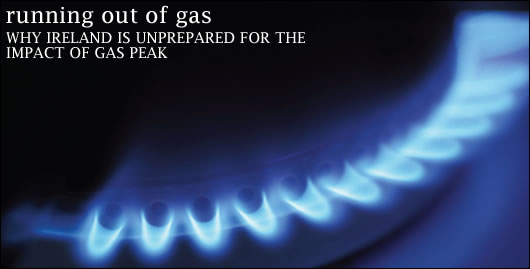
As we all know, Ireland is currently paying the price for the inability of its political and corporate leaders to take seriously the warning signs of an economy where property investment and borrowing generally got out of control. Looking at policy and commercial investment plans for energy supply and distribution, Richard Douthwaite asks, are the decision makers showing an alarmingly similar attitude to evident gas supply threats?
There is a significant chance that Ireland's gas supply from Britain will be cut off this winter and, if the disruption lasts more than a few hours, that electricity blackouts will occur and homes will be left without heat. This risk will only be eased in 2010 when Corrib gas starts coming ashore.
Gas supplies 27 per cent of Ireland's total energy demand and is burned to provide almost two-thirds of its electricity. As the gas fields off the coast of Cork are practically exhausted, almost all this gas comes from Britain. Two pipelines are used, both from the same terminal in Scotland at Moffat, which also supplies the gas used in Northern Ireland along another pipe. Consequently, if a problem develops at Moffat, or in the two pipelines that supply it, the whole of Ireland could lose almost all its gas supply for several months – depending, of course, on how bad the problem was.
Such problems do happen. In March this year, there was an explosion at Shell's main gas pumping station at Bacton in Norfolk, which handles a third of the British supply. Fortunately, only half the station was affected but gas prices shot up. Moreover, problems can take a long time to remedy. The oil pipeline terminal which blew up at Buncefield in Hertfordshire in 2005 has still not re-opened.
Another worry is that Britain is becoming increasingly dependent on importing gas itself as its North Sea reserves are depleted. In 2003 imported gas was used to meet just 2 per cent of British demand, but imports are expected to contribute almost 40 per cent this year and 80 per cent by 2018. This makes it a much less reliable supplier.
While Britain has a gas pipeline connecting it with Belgium and another to Holland, and two to bring in gas from the Norwegian North Sea, plus two Liquid Natural Gas (LNG) terminals where gas can arrive by tanker, it has an inadequate diversity of supply options to ensure it can get all the gas that it – and Ireland – needs. This is because both the Belgian and the Dutch pipeline bring in gas from the same main source – Russia – which has already demonstrated its willingness to use gas as a political weapon by turning it off.
Russia has about a third of the world's known gas reserves and is trying to set up a global gas cartel modelled on OPEC. In July it effectively took over Turkmenistan reserves by signing an agreement to buy all that country's gas for the next 20 years at a price based on whatever is the average of the wholesale gas price in Europe and in the Ukraine. This will double the price that Turkmenistan receives next year.
The Russian move may have destroyed the economic viability of the proposed Nabucco gas pipeline which was intended to provide an alternative to Russian supplies. It was planned to run from Turkey to Austria via Bulgaria, Romania and Hungary carrying Turkmen and other gas. “For the UK which has built an infrastructure based on cheap gas, this is a bleak picture indeed” the Oil Depletion Analysis Centre newsletter commented.
Britain realises that its growing reliance on imported gas is exposing it to risk, particularly as it only has 13 days' supply of gas in storage whereas Germany has 99 days and France has 122. Ireland has two. A British parliamentary committee wrote in a report published in July: “The Government has not responded quickly enough to the UK’s increasing, and entirely predictable, gas import dependency by encouraging investment in storage.”
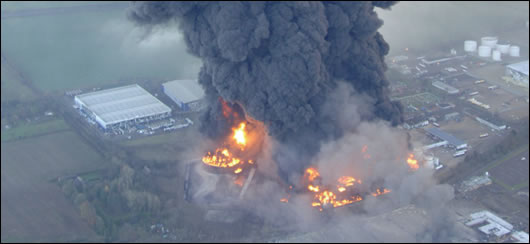
Aerial view of the explosions which occurred at the Buncefield oil storage depot, Hertfordshire, in 2005. Three years on, the depot has still not rot re-opened
If British gas supplies are cut for any reason, it has been agreed that whatever gas is available will be shared fairly with Ireland. “Supplies would be maintained in proportion to those available to equivalent market sectors in the UK” Bord Gáis wrote in its 2006 Annual Report. Domestic consumers would be cut off last in both countries.
So how soon would Irish homes lose their supply if deliveries from Britain stopped completely? According to the Commission for Energy Regulation, provided all gas-fired power stations stopped burning gas within five hours of the supply ceasing, domestic, commercial and industrial customers could be supplied with gas for a week under “typical winter” conditions or 48 hours during the statistically coldest winter in 50 years.
But, as gas is typically used to generate over 60 per cent of this country's electricity, and at one period last year was producing 87 per cent of it, would the lights go out? The answer, in theory, is no, because the gas-fired power stations can switch to using distillate oil. They are required to have five day's supply of oil on site and a spokesman for Huntstown power station, which can supply 20 per cent of the country's needs, told me that the switch-over can be carried out “in no time at all”.
The problem is that although only one small power station, Aghada 1, does not have the ability to switch fuels, the output of those which did would fall significantly – by as much as 15 per cent. This would make blackouts almost inevitable. “Even if the gas interruption lasts for just one week, and generators can deliver [their normal] level of output, there would still be a significant increase in the risk of electricity shortages. Should the gas interruption occur during a winter week a shortage in the range of 1000 MWhrs could be expected” Eirgrid's 2007 Generation Adequacy Report states. It adds that “a relatively modest reduction in secondary fuel capability of 10 per cent” would increase the electricity shortage by 600 per cent.
Once the gas supplies to homes run out after the British supply is cut, people will turn to electricity for heat instead. Electricity demand will soar and, if it has not happened already, customers will have to be cut off. “The electricity sector has a list of priority customers who are the last loads to be shed in the event of an electricity emergency” the Commission for Energy Regulation (CER) said in a document it issued last year. “Bord Gáis Networks is currently establishing a priority customer list detailing the natural gas loads that would be the last to be shed in the event of an emergency in the gas supply in addition to domestic customers who are always for safety and logistic reasons the last group to be shed in the event of an emergency.“

A photograph of the site for the proposed Shannon LNG terminal
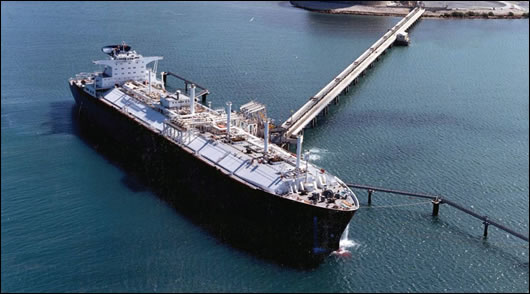
A typical LNG tanker
The CER is responsible for seeing that further supplies of distillate are available when the stocks at the power stations run out. It has passed this job to NORA, the National Oil Reserve Agency, which is charged with keeping enough oil to cover 90 days of Irish consumption ready for an emergency. However, a spokesman for the Department of Communications, Energy and Natural Resources told Construct Ireland that NORA has “no specific obligation as regards gas powered electricity generating stations. The EU requires that 90 days be kept in each of three categories – petrol, distillates and fuel oil. The distillate requirement may be met by keeping an aggregate of 90 days of kerosene, jet kerosene, gasoil and diesel in any combination. In other words there is no obligation to keep 90 days of gasoil.” So supplies to the power stations could well run out.
The gas supply situation will be greatly eased when Corrib gas begins to flow into the national gas grid, although, as Figure 1 shows, substantial imports from Britain will be needed even then. The latest news on the Corrib development is that the terminal itself is on course for completion in spring 2009. It will then undergo a six month commissioning process.

CLICK IMAGE FOR LARGE VIEW - Figure 1: The sources of Ireland's gas. The country will be almost wholly dependent on imports from Britain (the blue area) until Corrib gas (green) starts flowing, at least a year ater than shown here. It will not be possible to manage without British gas until the Shannon liquefied natural gas (cream) terminal opens in 2012. The purple area represents the aximum supply that it might be possible to draw for a short period through the Inch terminal in County Cork. This gas is largely British gas which is stored in the depleted Kinsale field although there is still a small amount of Irish production. Source: Bord Gáis
In theory, then, Corrib gas could be onstream by the end of next year as the e200 million, 149 kilometre pipeline connecting the terminal to the grid was completed in 2006. However, Shell employees say privately that early 2010 is a more realistic figure. One reason for their caution is that Bord Pleanala has not yet given its consent for the construction of a section of the controversial high-pressure pipeline running from the point at which the gas comes ashore to the terminal itself.
Bord Pleanala is handling Shell's application for consent for this pipeline under the Strategic Infrastructure Act. The company expects it will hold an oral hearing in October and hopes for a favourable decision before the end of the year. The pipeline could then be completed by the time the terminal has been commissioned.
Only the opening of the liquefied natural gas terminal planned at Tarbert on the Shannon will enable Ireland to manage without getting any of its gas from or through Britain. The terminal is to be built on a 257 acre site by Shannon LNG, an Irish-registered subsidiary of Hess LNG Ltd, which is in turn a joint venture of two US companies, the Hess Corporation and Poten & Partners. It will be the firm's first terminal although it does have plans for a second in Boston, Mass.
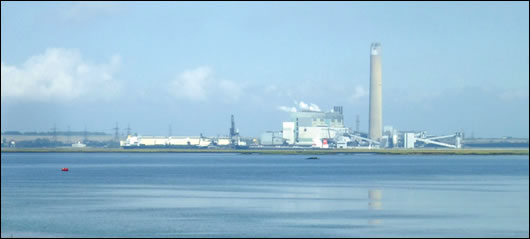
Britain's main LNG terminal on the Isle of Grain has scarcely been used this year, with flexible supply contracts allowing ships to divert course to higher paying markets
LNG is natural gas that has been cooled to approximately minus 160°C to liquefy it, thus reducing its volume 600 times. This makes it feasible to transport around the world. The liquid gas is stored and transported in insulated tanks; it is the very low temperatures rather than high pressures which keep it liquid. It is not under pressure in ships or in tanks ashore.
Work will start on the project next summer provided that Bord Pleanala's planning permission is not overturned. A judicial review of this permission is being sought by Friends of the Irish Environment and a local group, the Kilcolgan Residents' Association, on the grounds that the Health and Safety Authority failed to give proper technical advice on the risks of major accidents at the terminal. The application is expected to be heard in the Commercial Court this October.
The cost of the project is e500 million, the same figure that was given some years ago as the cost of Corrib gas terminal excluding its pipelines (These days Shell refuses to divulge the total cost of its terminal and pipelines but the commonly-used figure is e900 million). If the project proceeds, it should open in 2012. With the pipelines from Britain and the Corrib field, Ireland will then have three independent sources of gas and, as the pipes from Britain already operate as common carriers, companies selling gas here will be able to get a supply through them from one of the two British LNG terminals, a North Sea well or a European supplier connected to the continental grid. The hope is that this will create an Irish gas market along the lines of the one for electricity, with several competing suppliers.
So that this market can develop, and to satisfy EU directives, the gas grid is being taken away from Bord Gáis in the way that the ESB had to hand over the electricity grid to Eirgrid. Gaslink, an “independent” subsidiary of Bord Gáis became responsible for operating, maintaining and developing the natural gas transmission and distribution systems, including the interconnectors on July 4th this year. Quite how independent Gaslink will become remains to be seen, given that Bord Gáis will continue to own the pipelines and be responsible for any work on them. Its board is Denis Cronin, Rie McGowan, Kathleen O’Sullivan and Liam O’Riordan. Ms. O'Sullivan is listed on the Bord Gais website as its head of corporate affairs.
Seven companies are already listed by the CER as gas suppliers besides Bord Gáis. The most notable name to have been added to the list recently is Gazprom, the biggest Russian producer, which already has a small company selling gas through the British grid and which expressed interested in buying Centrica, the parent company of British Gas, in 2006. The British government was alarmed at the prospect of having a company controlled by the Russian government becoming responsible for gas and electricity supplies to 17 million customers but Gazprom will have an increasing amount of clout in Britain nevertheless.
It seems that the Shannon terminal will import gas on its own account and sell it to Irish distributors, rather than charging others to use the facility, as is done at the Isle of Grain. It will need to sell a lot of gas at a decent margin to give its backers a good return on the amount of money they are investing. What will the international LNG market look like when it becomes operational? The best guess is “very tight indeed.” The reason for believing this is that Europe's own supplies of gas are on the point of going into a decline while North American gas production is already dropping and about to do so at a dramatic rate, as Figure 2 shows.
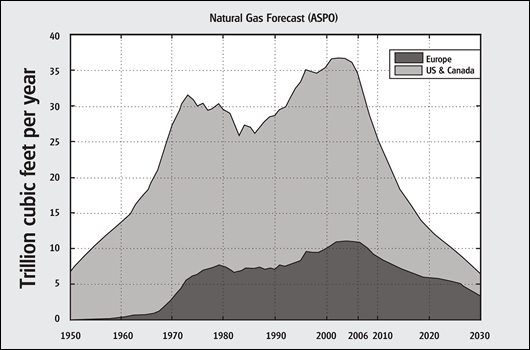
CLICK FOR LARGER VIEW - Figure 2: Gas supplies to the European and North American markets are expected to decline rapidly in the near future and it will be expensive to bring supplies in from elsewhere. Europe as been looking to Russia for its supplies despite the political price to be paid. Production in the former Soviet Union as a whole is expected to begin to decline around 2020. The data are from Jean Laherrere. Source: http://europe.theoildrum.com
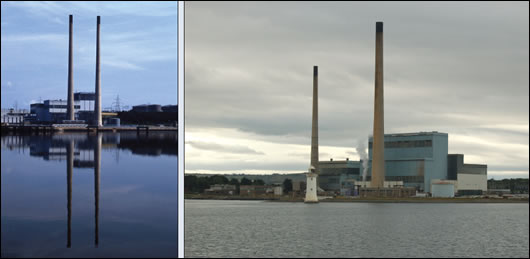
Great Island power station (above left) and Tarbert power station (above right) are planned to be replaced with combined-cycle gas-fired plants
This means that the North Americans will increasingly turn to LNG imports to make up the shortfall. This will push up its price. A lot of gas is now being sold in flexible contracts which allow LNG tankers to be diverted at sea to whatever market is currently offering the highest gas price. As a result, LNG is already more expensive than pipeline gas and Britain's main LNG terminal on the Isle of Grain has scarcely been used this year. “Japan, South Korea, China, India, Turkey and Spain have all increased their demand for LNG this year” the British parliamentary committee report explained.
Algeria, Egypt and Libya are planning to expand their LNG production but their output is expected to peak in 2015. Russia's three biggest gas fields - Yamburg, Urengoy and Medvezhye - are already in decline and one commentator believes that the country will struggle to maintain supplies to Europe from “second tier assets” particularly as it is also intending to supply increased amounts of gas to China.
Qatar, which has the third largest reserves of natural gas in the world, (Iran is second) recently put a moratorium on new gas projects apart from those already approved. The reason it gave was that it wanted to study its North Field reservoir, the largest in the world, but some people believe that the real reason is that the country is already earning more money from its gas sales than it knows what to do with and consequently has no incentive to expand. It could invest the money, of course, but it would be hard for it to find projects that would give a return approaching that which can be expected from just keeping the gas in the ground, where its value will increase in real terms in step with world gas prices. Qatar, Russia, and Iran together hold about half of the world's gas supplies. All three met recently to discuss the “gas-OPEC” cartel concept. Algeria and Venezuela also took part.
It therefore seems that gas is likely to become a much more costly fuel in future, and this will inevitably push up the price of Irish electricity. At least one authority, a Norwegian energy analyst, Rune Likvern, believes that it will only be possible for Europe as a whole to maintain supplies at their current level. His projections show an increasing gap emerging between the available supply and the growth of demand under a business-as-usual scenario. This expected growth in demand will, of course, be choked off by rising prices.
If Likvern's view is accepted, it is obviously foolish for Gaslink to continue to extend its network. It recently spent e40 million to make gas supplies available to eleven Mayo towns, including Castlebar and Westport, and contracts have been given to enable Cashel and Cahir to be joined up next year. A report on the connection of 35 more towns around the country will be published this autumn.
It is equally silly for any more combined cycle gas-fired (CCGT) power stations to be built. The Generation Adequacy Report warns that the plans to close three power stations that burn heavy fuel oil - those at Tarbert, Great Island and Poolbeg - and to replace them with gas-fired CCGT plants will increase the country's reliance on gas. The level of gas dependency that would result, it says “while currently manageable, will need to be carefully monitored as the gas supply-demand situation evolves.” It also suggests that it would be better to install open cycle turbines rather than combined cycle ones as these can cope better with fluctuations in demand. They therefore make it easier for wind farm electricity to be accommodated by the grid.
Despite this, and the fact that it is government policy to reduce electricity's dependence on gas to less than 50 per cent, the CER has approved the construction of CCGT stations at Whitegate and Aghada, with completion dates of May 2010 and October 2009 respectively. Moreover, last December, it directed Eirgrid to offer a grid connection to Sean Quinn for another CCGT station at Ballakelly, County Louth.
The idea that gas may be scarce and expensive in future does not appear to have been considered by either Gaslink or the CER. Construct Ireland asked for an interview with Aidan O'Sullivan, Gaslink's general manager, to get his views on the future availability of gas and the effect this might have on his company's investment decisions. We were told that he was unavailable and Gaslink’s PR company issued a statement instead. This maintained that the present situation was sound: “In terms of security of supply, Ireland is well positioned with secure physical interconnection and contractual arrangements in place with the UK gas market. The UK has access to highly diverse sources of supply though its own indigenous production, Norwegian imports, physical interconnection with mainland Europe and access to worldwide markets through LNG facilities.”
Although the CER says its mission “in a world where energy supply and prices are highly volatile ... is to ensure that the lights stay on [and] the gas continues to flow” it sees no problems ahead either. Its annual Gas Capacity Statement (GCS), issued this July, looks forward 20 years and states “Overall, the longer term prospects for security of supply appear to be relatively positive, particularly compared to previous years.” It does not mention the price at which gas might be available during this period.
As a result, it projects gas demand rising over the next seven years on a business-as-usual basis and assumes that this demand can be met. This cornucopian supply assumption means that the CER has no reason to refuse Gaslink consent for the continued expansion of the grid, or Sean Quinn and others for power stations which increase Irish gas use. Yet the only basis on which either type of consent makes sense is if there is far more gas off the Irish coast than we've been led to believe, a possibility the GCS mentions but says is not taken into account in its projections.
We all know that today's problems in the construction industry and the banking sector arose because the financial regulator failed to call a timely halt to the expansion of property-based lending. The energy regulator is making the same mistake in failing to call a halt to the expanding use of gas and the consequences could be equally serious. Indeed, people could die. The only person capable of freeing Gaslink and the CER from their expansion-as-usual thinking is the minister himself. Eamon Ryan organised meetings to discuss peak oil long before the idea became popular. It's now time for him to start talking to the state bodies for which he's responsible about peak gas, too.
Related items
-
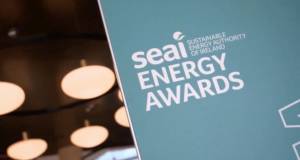 SEAI Energy Awards 2020 open for entries
SEAI Energy Awards 2020 open for entries -
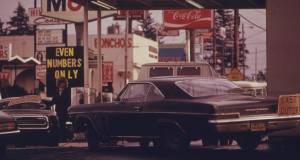 The first oil crisis
The first oil crisis -
 SEAI Energy Show back at RDS on 27 & 28 March
SEAI Energy Show back at RDS on 27 & 28 March -
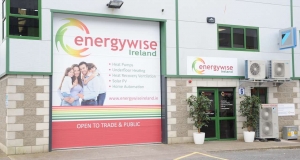 Energywise Ireland open new renewables showroom
Energywise Ireland open new renewables showroom -
 Together in Electric Dreams
Together in Electric Dreams -
 Passive House Plus back issues now freely available online
Passive House Plus back issues now freely available online -
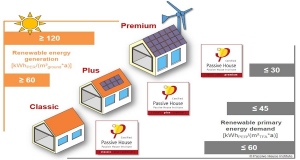 Passive House Institute launches new cert categories
Passive House Institute launches new cert categories -
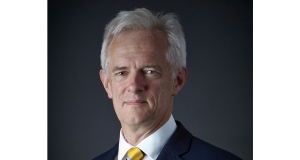 Passive house: an alternative method of meeting Part L?
Passive house: an alternative method of meeting Part L? -
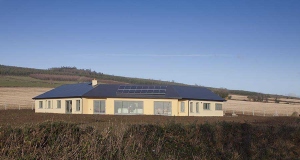 Do Ireland’s energy efficiency regulations penalise energy efficiency?
Do Ireland’s energy efficiency regulations penalise energy efficiency? -
 Ireland’s energy roadmap — have your say
Ireland’s energy roadmap — have your say -
 Windhager to launch new BioWin 2 pellet boiler at Ecobuild
Windhager to launch new BioWin 2 pellet boiler at Ecobuild -
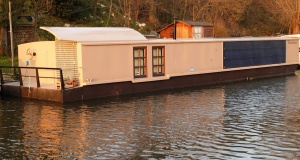 The Bauhaus Barge: an energy efficient canal boat
The Bauhaus Barge: an energy efficient canal boat

